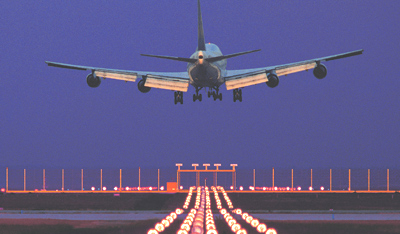Instrument Landing System
ILS stands for
Instrument Landing System and simply stated is what pilots use to safely guide
their aircraft to the runway when the weather conditions do not allow for a
visual approach and landing. Such conditions make it very difficult or even
impossible to see ahead, so using radio signals (sometimes coupled with
high-intensity lights) the pilot can safely navigate the aircraft through low
ceilings, rain, dense fog, snow, and safely land.

The radio signals are ground-based and are sent continuously. Containing two
separate parts, the signals guide the pilot (or autopilot) both to the
centerline of the runway and down a safe rate of descent, or glideslope.
 |
| ILS Glideslope and Localizer |
To use the ILS,
the pilot must tune the navigation radio receiver in the cockpit to the
appropriate frequency for the runway to be used. Once tuned to the proper
frequency the pilot can then guide the aircraft along the path set by the radio
frequency by either hand-flying or by using the autopilot. When hand-flying the
aircraft, the pilot uses the horizontal situation indicator, or HSI, to follow
both the glideslope and localizer. When tuned to the proper frequency, the
navigation radio, or NAV, sends a signal to the HSI and two indicators will
appear.
 |
| ILS Indicator on Flight Control Panel |
The indicators are oriented perpendicular to each other - one oriented
horizontally and the other vertically. The pilot maneuvers the aircraft so that
the indicators form a "+" in the center of the HSI. When this occurs,
the pilot knows that the aircraft is both on the proper glide path and is lined
up with the runway. When the pilot decides to use autopilot, the autopilot
performs the same task.
As the aircraft
approaches the runway, it passes over ground-based radio beacons (typically
three) set along the localizer which send signals to the navigation radio
telling the pilot approximately how far the aircraft is from the runway. This
is accomplished by the navigation radio taking the signals and interpreting
them, and producing an audible tone for the pilot.
 |
| Marker beacon on Glide slope |
| Various parts of an ILS |
 |
| Visual Indicators for ILS markers |
The beacons are called 'markers', and each marker has a different tone to distinguish distance from the runway but each marker of the same type will be uniform. The 'outer marker' has a low-pitched tone and a long duration. It lets the pilot know that the runway is approximately 3.5 to 6 nautical miles from landing and is indicated by a blue light. The 'middle marker' has a higher tone than the outer marker and the tone repeats more frequently (two each second) and lets the pilot know that they are near the missed approach point in low-visibility conditions and has a corresponding amber light. Finally, the 'inner marker' indicates that the arrival at the runway threshold is imminent. It is distinguished by a white light and morse 'dots' at 3kHz.
Using this technology has increased the safety of travelling by air
significantly and will continue to prevent air disasters while improving the
efficiency and flow of aircraft both in and out of airports around the world.
For animation of ILS, log onto : http://instrument.landingsystem.com/ils-tutorial-animation/
No comments:
Post a Comment